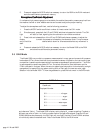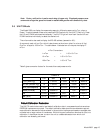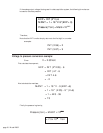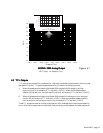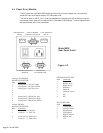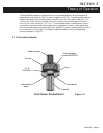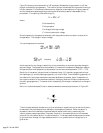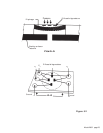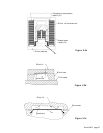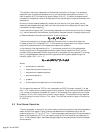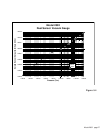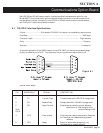
page 22 Model 2002
dV
dT
0
0
dV
1
dT
V
1
S
dS
dT
therefore
K
R
L
R
L
dV
dT
P
(
SdV
d
T
VdS
dT
)
0
Figure 5.2 shows a typical schematic of a B implanted Wheatstone bridge network in a Si dia-
phragm inverted box type geometry. The inside of the box is evacuated during anodic bonding to
a Pyrex substrate. The membrane has maximum deflection at atmosphere (or higher pressure)
and the membrane resistances change value as the differential pressure is decreased during
pumpdown. The resulting differential output is
V
o
= SPV+V
1
where
S is the sensitivity
P is the pressure
V is the applied bridge voltage
V
1
is the no load output voltage
Since the sensitivity changes so dramatically with temperature, some correction is required for
compensation. The change in output voltage
To insure temperature invariance,
which requires for any change in sensitivity to be countered by an equal but opposite change in
applied voltage. The temperature compensation is a network of temperature dependent resistive
components and fixed temperature compensation current source compensation, TCR = -TCS.
Sensitivity of the sensor is proportional to the sensor factor (K), the strain gauge positioning of
the diaphragm (φ) and the diaphragm geometry (θ) thus S
∝Kφθ. Once the defining geometry of
the resistive film and piezo membrane have been established, the sensor factor is dependent on
the crystal orientation of the membrane material, the doping level and diffusion parameters and
the strain gauge geometry. The sensor factor is essentially the change in resistance for a change in
strain or,
Boron ion implanted doped Si matrix resistance elements are employed as shown in Figure 5.2.
The die is electrostatically bonded on to a Pyrex substrate in a good vacuum so that the die cavity
is evacuated, this provides maximum deflection at atmospheric pressure. When the sensor is
exposed to vacuum the deflection becomes less and less as the die cavity pressure and the
vacuum system pressure equalizes. Eventually the strain in the membrane due to ∆P becomes
zero and only the residual strain in the lattice remains. The bridge resistive elements are oriented
to give maximum change in bridge resistance which in turn gives maximum voltage out for a
given strain.



